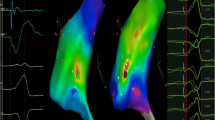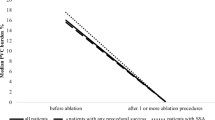Abstract
Background
The aim of the present study was to determine the predictors of adequate intraprocedural premature ventricular complex (PVC) frequency for successful mapping and ablation of idiopathic PVCs.
Methods
A total of 101 consecutive patients (45 men; age: 47.9 ± 14.2 years) who had undergone idiopathic PVC ablation between 01 November 2018 and 24 June 2020 constituted our study population. Clinical and demographic data, procedural details and 24 h rhythm recordings that had been recorded before the procedure were retrospectively evaluated. Total PVC burden and diurnal variability assessed by the ratio of night time (22:00–06:00) over day time (06:00–22:00) PVC burden was calculated. The relationship between hourly PVC number and heart rate was also evaluated for each patient. Clinical characteristics and Holter parameters were compared between groups with and without adequate intraprocedural frequency of PVCs that permitted activation mapping.
Results
In all, 27 patients (26.7%) had infrequent intraprocedural PVCs which necessitated isoproterenol infusion or cancellation of ablation procedure due to inability of activation mapping. PVC burden was significantly higher in the group with frequent intraprocedural PVCs (26.1 ± 9.4% vs 21.2 ± 10.3%; p: 0.026). There were no significant differences between groups regarding the relationship between hourly PVC number and heart rate or the ratio of night/day PVC burden. Binary logistic regression analysis revealed the 24 h Holter PVC burden as the sole parameter that is significant predictor of frequent intraprocedural PVCs permitting activation mapping.
Conclusion
The 24 h PVC burden was the only predictor of adequate intraprocedural PVC frequency permitting activation mapping during idiopathic PVC ablation.
Zusammenfassung
Hintergrund
Ziel der vorliegenden Studie war es, Prädiktoren für eine adäquate intraprozedurale PVC(„premature ventricular complex“)-Frequenz für ein erfolgreiches Mapping und eine Ablation wegen idiopathischer PVCs zu bestimmen.
Methoden
Insgesamt 101 konsekutive Patienten (45 Männer; Alter: 47,9 ± 14,2 Jahre), die sich zwischen dem 01. November 2018 und dem 24. Juni 2020 einer Ablation wegen idiopathischer PVCs unterzogen hatten, bildeten das Studienkollektiv. Klinische und demographische Daten, Einzelheiten zum Verfahren und vor dem Eingriff erstellte 24-Stunden-Rhythmusaufzeichnungen wurden retrospektiv ausgewertet. Ermittelt wurden dabei die PVC-Belastung insgesamt und die tageszeitliche Variabilität, bewertet anhand des Quotienten aus PVCs während der Nacht (22:00-06:00 Uhr) und während des Tages (06:00-22:00). Auch die Beziehung zwischen der Anzahl der PVCs pro Stunde und der Herzfrequenz wurde für jeden Patienten ausgewertet. Klinische Charakteristika und Holter-Parameter wurden verglichen zwischen Gruppen mit und ohne für ein Aktivierungsmapping adäquate PVC-Frequenz während des Eingriffs.
Ergebnisse
Insgesamt 27 Patienten (26,7 %) hatten während des Eingriffs eine so niedrige PVC-Frequenz, dass aufgrund der Unmöglichkeit des Aktivierungsmappings eine Isoproterenol-Infusion oder ein Abbruch des Ablationsverfahrens erforderlich war. Die PVC-Belastung war in der Gruppe mit häufigen intraprozeduralen PVCs signifikant höher (26,1 ± 9,4 vs. 21,2 ± 10,3 %; p = 0,026). Es gab keine signifikanten Unterschiede zwischen den Gruppen hinsichtlich der Beziehung zwischen PVCs pro Stunde und der Pulsfrequenz oder des Quotienten aus Nacht- und Tages-PVC-Belastung. In der binären logistischen Regressionsanalyse erwies sich die 24-Stunden-Holter-PVC-Belastung als der einzige Parameter, der einen signifikanten Prädiktor darstellt für die PVC-Frequenz, die während des Eingriffs ein Aktivierungsmapping erlaubt.
Schlussfolgerung
Die 24-Stunden-PVC-Belastung war der einzige Prädiktor für eine PVC-Frequenz, die ausreichend war, um ein Aktivierungsmapping während einer Ablation bei idiopathischen PVCs zu ermöglichen.

Similar content being viewed by others
References
Adams JC, Srivathsan K, Shen WK (2012) Advances in management of premature ventricular contractions. J Interv Card Electrophysiol 35:137–149
Noheria A, Deshmukh A, Asirvatham SJ (2015) Ablating premature ventricular complexes: Justification, techniques, and outcomes. Methodist Debakey Cardiovasc J 11:109–120
Cronin EM, Bogun FM, Maury P, Peichl P, Chen M, Namboodiri N et al (2019) 2019 HRS/EHRA/APHRS/LAHRS expert consensus statement on catheter ablation of ventricular arrhythmias. J Arrhythm 35:323–484
Asirvatham SJ (2009) Correlative anatomy for the invasive electrophysiologist: outflow tract and supravalvar arrhythmia. J Cardiovasc Electrophysiol 20:955–968
Lee A, Walters TE, Gerstenfeld EP, Haqqani HM (2019) Frequent ventricular ectopy: Implications and outcomes. Heart Lung Circ 28:178–190
Gillis AM, Guilleminault C, Partinen M, Connolly SJ, Winkle RA (1989) The diurnal variability of ventricular premature depolarizations: Influence of heart rate, sleep, and wakefulness. Sleep 12:391–399
Hamon D, Abehsira G, Gu K, Liu A, Blaye-Felice Sadron M, Billet S et al (2018) Circadian variability patterns predict and guide premature ventricular contraction ablation procedural inducibility and outcomes. Heart Rhythm 15:99–106
Hamon D, Swid MA, Rajendran PS, Liu A, Boyle NG, Shivkumar K et al (2019) Premature ventricular contraction diurnal profiles predict distinct clinical characteristics and beta-blocker responses. J Cardiovasc Electrophysiol 30:836–843
Yu Q, Wang J, Dai M, Zhang Y, Cao Q, Luo Q et al (2020) Night-time premature ventricular complex positively correlates with cardiac sympathetic activity in patients undergoing radiofrequency catheter ablation. Heart Lung Circ 29:1152–1163
Koca H, Kucukosmanoglu M, Icen YK, Koca F, Ardic ML, Koc M (2020) A new approach to radiofrequency catheter ablation of premature ventricular contractions: The diurnal variation index. J Electrocardiol 59:106–111
Morganroth J, Michelson EL, Horowitz LN, Josephson ME, Pearlman AS, Dunkman WB (1978) Limitations of routine long-term electrocardiographic monitoring to assess ventricular ectopic frequency. Circulation 58:408–414
Jhuo SJ, Lo LW, Chang SL, Lin YJ, Chung FP, Hu YF et al (2017) Characteristics of diurnal ventricular premature complex variation in right ventricular outflow tract arrhythmias after catheter ablation. Medicine 96:e6516
He W, Lu Z, Bao M, Yu L, He B, Zhang Y et al (2013) Autonomic involvement in idiopathic premature ventricular contractions. Clin Res Cardiol 102:361–370
Bas HD, Baser K, Hoyt J, Yokokawa M, LaBounty T, Morady F et al (2016) Effect of circadian variability in frequency of premature ventricular complexes on left ventricular function. Heart Rhythm 13:98–102
Author information
Authors and Affiliations
Corresponding author
Ethics declarations
Conflict of interest
S. Demir, K. Gulsen, A. Kepez, A. Uslu, A. Kup, B.G. Kanar, F. Kayan, C. Yildirim and T. Akgun declare that they have no competing interests.
All procedures performed in studies involving human participants or on human tissue were in accordance with the ethical standards of the institutional and/or national research committee and with the 1975 Helsinki declaration and its later amendments or comparable ethical standards. Informed consent was obtained from all individual participants included in the study.
Rights and permissions
About this article
Cite this article
Demir, S., Gulsen, K., Kepez, A. et al. Predictors of adequate intraprocedural premature ventricular complex (PVC) frequency during idiopathic PVC ablation. Herz 46, 476–481 (2021). https://doi.org/10.1007/s00059-020-05017-8
Received:
Revised:
Accepted:
Published:
Issue Date:
DOI: https://doi.org/10.1007/s00059-020-05017-8
Keywords
- Activation mapping
- Arrhythmias, cardiac
- Radiofrequency ablation
- Diurnal variability of premature ventricular complexes
- Heart diseases




